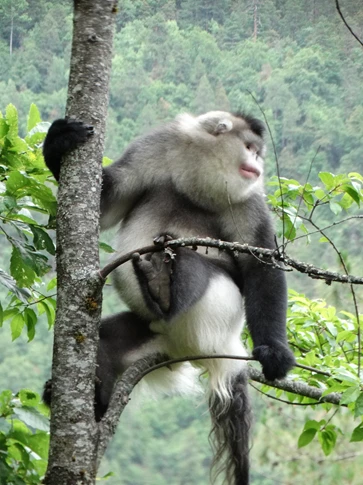
Recently, the IUCN World Conservation Union announced that the Giant Panda is no longer globally endangered with extinction, but has been “down-listed” to globally vulnerable. The Fourth National Survey (2011-2014) in China estimated the range-wide population as 1,864 adult Giant Pandas, and that at least one distinct population, in the Minshan Mountains, includes more than 400 mature individuals. National surveys indicate that the past trend of decline has stopped, and the panda population has started to increase. Forest protection and reforestation in China has increased forest cover over the past decade, leading to an 11.8% increase in forest occupied by pandas and a 6.3% increase in suitable forests that are not occupied, yet.
In a world where the loss of wild species has become so commonplace that it hardly makes headlines anymore, it is worth looking more deeply at what went right in this particular case. We believe that there is a direct connection with some major interventions that occurred more than 15 years ago, such as the China-World Bank-GEF Nature Reserve Management Project (NRMP), in which we were fortunate to have played a role as the World Bank task team leader of the Project and as one of the international wildlife and protected areas specialists on the government team. That project, in particular, contributed significantly to enhancing the habitats of the panda and other species that share its range. We remember when the national masterplan for Giant Panda conservation first came out in 1992; most in the conservation community in China thought it was a wild fantasy. It was only through the nuts and bolts of implementation, which the NRMP advanced between 1996 and 2001, that key parts of that master plan became a reality.
The impacts of the NRMP went far beyond the five panda nature reserves—Taibai, Changqing, Zhouzhi, Niubeijiang and Foping NR--that it touched directly. The project introduced science-based monitoring, results-based management planning, and participatory approaches with adjacent communities, and provided capacity building for staff from the national nature reserve management office in Beijing to a dozen national-level nature reserves, several of which subsequently became models for the country.
The project also introduced a viable model for transforming forest production enterprises into forest conservation agencies – an intervention which was very timely, as the approach became a vital part of subsequent efforts to turn around China’s forest enterprises in 1998. Catastrophic floods in 1997-1998 made it clear that clear-cutting natural forests created downstream costs that far exceeded any revenue streams obtained from logging. Providing alternative livelihoods and payments for ecological services to people who previously depended on unsustainable use of wild resources has now become a key pillar in China’s efforts for forest conservation and biodiversity protection.
The NRMP and a follow-on project, the China-World Bank-GEF Sustainable Forest Development Project, with other interventions have succeeded in transforming the approach to biodiversity conservation in China. These impacts have proven to be long lasting and wide ranging. One of us just got back from a drive around Baima Snow Mountain National Nature Reserve in Yunnan Province, which was among the nature reserves that were included in the PAM component. The impact of those interventions is still evident there, in the professionalism of the staff and their collaborative approach to relationships with surrounding communities, and in the resulting recovery of forests and wildlife populations, including the rare and charismatic Yunnan Snub-nosed Monkey.
These two large scale interventions were not only implemented according to the stated objectives, but also stayed the course against all special interests that tried to water down the approaches. Success can be attributed to the long term partnership between the State Forestry Administration and the World Bank which promoted innovation and experimentation; the willingness of different levels of forestry administration to work with local communities and other key stakeholders; and events like the logging ban, which changed the goals and the mindset of the larger forestry community. All of this came together to enable the success of an equitable and sustainable approach that would ensure a lasting future for China’s rich heritage of varied natural habitats and unique wild species like the Giant Panda.
We hope that we can be a part of something so influential again someday.



Join the Conversation